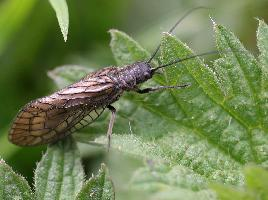
Weights and measures
| Length | 25 mm |
|---|---|
| Wingspan | from 19 to 38 mm |
Animal description
The Alderfly, scientifically known as Sialis lutaria, is a fascinating insect that belongs to the order Megaloptera and the family Sialidae. This intriguing species can be found near freshwater habitats across various parts of Europe and Asia, making it a common sight for those exploring rivers, streams, and lakes. The Alderfly plays a significant role in its ecosystem, serving as both predator and prey in its aquatic environment.Adult Alderflies are characterized by their distinctive appearance. They typically measure between 10 to 20 millimeters in length, displaying a dark, almost black coloration that helps them blend into their surroundings. One of the most notable features of the Alderfly is its large, membranous wings, which are held tent-like over their bodies when at rest. These wings are veined and slightly smoky in appearance, contributing to their unique look. The insects also have long, filamentous antennae, which are often as long as or longer than their body, adding to their distinctive silhouette.
The lifecycle of Sialis lutaria is particularly interesting, as it includes a complete metamorphosis with distinct egg, larval, pupal, and adult stages. The females lay their eggs in clusters on vegetation overhanging water bodies. Upon hatching, the larvae, known as "sialid larvae," drop into the water where they will spend the majority of their life cycle. These larvae are voracious predators, feeding on a variety of small aquatic invertebrates. They have a somewhat flattened, elongated body that is dark brown to black in color and equipped with strong mandibles for capturing prey. The larval stage can last for one to two years, depending on environmental conditions.
As the larvae mature, they construct a cocoon in which to pupate, often in the soil or under debris near the water's edge. The pupal stage lasts for a few weeks, after which the adult Alderflies emerge. Adult Alderflies are short-lived, with their primary purpose being to reproduce. They do not feed during their adult life, which typically lasts for only a few days to a couple of weeks.
Alderflies are not only fascinating due to their lifecycle and appearance but also because of their role in the ecosystem. Larval Alderflies are important predators of other aquatic invertebrates, helping to control their populations. In turn, both larvae and adults serve as a food source for a variety of fish, birds, and other wildlife, making them an integral part of the food web in freshwater ecosystems.
In conclusion, the Alderfly, Sialis lutaria, is a remarkable insect with a unique appearance and an interesting lifecycle. Its presence in freshwater habitats across Europe and Asia adds to the biodiversity of these ecosystems, highlighting the importance of conserving natural habitats for the continued survival of species such as the Alderfly.
New photos of animals
Top 10 animals
- Dolphin gull (Leucophaeus scoresbii)
- Diana monkey (Cercopithecus diana)
- Moustached guenon (Cercopithecus cephus)
- Galápagos tortoise (Geochelone nigra complex)
- Japanese macaque (Macaca fuscata)
- Stone loach (Barbatula barbatula)
- Russian tortoise (Testudo horsfieldii)
- Greek tortoise (Testudo graeca)
- Common flying dragon (Draco volans)
- Vendace (Coregonus albula)